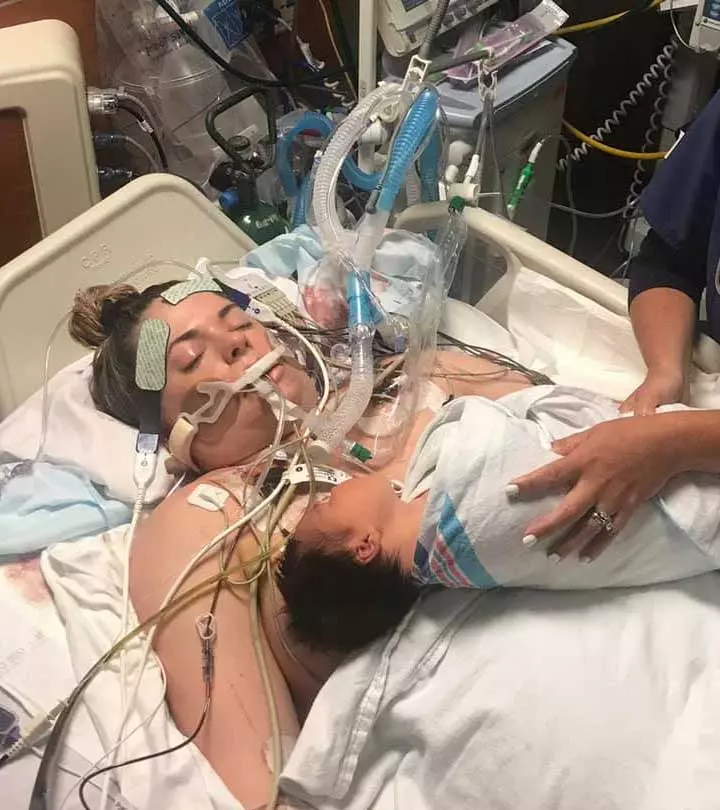
The common concept behind an untimely death during childbirth is that the mother’s body could not handle the pain and bled too much or some other complication happened while giving birth. People tend not to think too deeply about these serious causes and point at the fact that the mother’s body was too weak. Many other superstitious beliefs also are suggested. This anecdote is about Kayleigh Summers, who had a reasonably uncomplicated pregnancy. Childbirth, though, was a whole other story altogether. Today, she is a happy mother of a two-year-old son, Callahan — but her journey to get here was a scary and unexpected one. This is a story of a woman who almost stood at the threshold of death when giving birth to her child. You’d think that given how advanced technology is, death by childbirth is a matter of yesterday. In fact, it is best to grow out of that reality as it is still happening to many pregnant women and hits them in an unpredictable manner. But even still today, there is something unheard of, which comes with no warning – Amniotic Fluid Embolism. Keep reading to find out more:
What Happened To Kayleigh?

Image: Facebook: kayleigh.summers.3
Labor is not an easy experience, but during the course of her childbirth, Kayleigh complained of feeling extremely ill. The nurses tried to comfort her, telling her that feeling off during labor was absolutely normal. They were wrong because, soon enough, Kayleigh slipped into a cardiac arrest. What started off as a normal delivery had turned into a C-section; Kayleigh was now a code blue, which meant she needed immediate medical intervention. The tension in the operation theatre was palpable — the doctors had to deliver her baby while performing a Cardiopulmonary Resuscitation (CPR) on her. The good news was that her son was born, and he was healthy. The bad news was that Kayleigh’s condition was getting worse!
She began bleeding profusely — by the end of the entire ordeal, she required close to 143 units of blood. Additionally, Kayleigh also had to get a hysterectomy to curb the loss of blood. Her lungs and heart were both affected, due to which they weren’t performing at the required capacity. So, she needed an ECMO — Extracorporeal Membrane Oxygenation, a machine that could artificially keep your body oxygenated. That was not all. With her heart getting weaker by the minute, the doctors also implanted an impeller, which is a device that allows the heart to rest while it does the job of pumping oxygen-rich blood to the body.
This ordeal lasted for a week — a week that she had no memory of! This meant that she also missed out on the first week of her son’s life. It’s all about timely and efficient treatment by the medical team since this unrecognizable but serious disease can occur without any signs. Let’s find out what Amniotic Fluid Embolism is and what you should look out for when you’re in labor:
What Is Amniotic Fluid Embolism?

Image: Shutterstock
A rare but extremely serious condition, an Amniotic Fluid Embolism essentially takes place when the amniotic fluid leaks into the mother’s system, namely her bloodstream, and then makes its way to the rest of her body. The amniotic fluid that seeps into the mother’s system may contain cells, baby hair, or even skin. As these particles enter the bloodstream, they make their way into the mother’s lungs and heart and prove to be fatal. These fetal tissues are technically foreign objects in the mother’s system, so the body goes into an allergic shock reaction.
As a reaction to the amniotic fluid, your body can experience Disseminated Intravascular Coagulation, as well as a cardiac arrest. You can also experience a massive blood clot, which in turn can lapse into a Disseminated Intravascular Coagulation (1). Once this happens, your body responds with another reaction, where it begins to experience severe hemorrhage or bleeding. Immediate medical intervention is required when a woman faces this problem. A few other complications that a mother may face include fetal distress or death of the baby, multiple organ failure, or severe brain injury (2).
In most cases, it happens during delivery. However, it can also occur during the postpartum period. Unfortunately, an Amniotic Fluid Embolism is extremely hard to diagnose, and it can take you by surprise. There is no certainty when the fluid escaped into the bloodstream or how long it takes to clog the organs. It is always best to take all the precautions and be under observation if there are any hints of complications.
What Are The Symptoms Of Amniotic Fluid Embolism?

Image: Shutterstock
Although this condition cannot be diagnosed well in advance, a few symptoms are associated with it. This includes severe difficulty in breathing and loss of consciousness. You may also experience seizures, nausea, vomiting, agitation, and discoloration of your skin.
Childbirth, in itself, is a traumatic experience — it is difficult for a woman to differentiate between what’s normal and what isn’t. Since they are already going through the pain, whether it is a normal delivery or cesarean, discomfort might be associated with the act of giving birth and not any other health issue. Medical health practitioners must watch out for these symptoms, especially since this condition comes by unannounced. Amniotic Fluid Embolism is a fatal condition — according to statistics, the maternal mortality rate stands at eight percent (3).
What Kayleigh suffered through was terrible, and when asked about it, she said that it was hurtful to have missed out on her child’s first week of life. When her baby was placed in her arms after she survived the embolism, the experience was surreal. But she is grateful for this new lease on life. Today, both mother and son are hale and hearty. You can spread awareness by sharing real-life stories like these and cutting down the sufferings of childbirth. Through her story, we hope to bring to light this dangerous possibility during childbirth. What are your thoughts on this? Let us know in the comments below!
References
- Successful treatment of amniotic fluid embolism complicated by disseminated intravascular coagulation with rivaroxaban
https://www.ncbi.nlm.nih.gov/pmc/articles/PMC7004698/ - Amniotic Fluid Embolism
https://www.birthinjuryhelpcenter.org/birth-injuries/delivery-complications/amniotic-fluid-embolism/ - Amniotic Fluid Embolism
https://emedicine.medscape.com/article/253068-overview
Community Experiences
Join the conversation and become a part of our nurturing community! Share your stories, experiences, and insights to connect with fellow parents.












